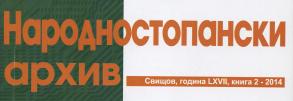-
В. Хаджиев
Асиметрична специализация на износа
в условията на либерална международна търговия
Резюме:
Асиметричната специализация на износа е характерна черта на съвременната либерална търговия. Тя се изразява в това, че голяма част от страните изнасят предимно суровини и нискообработени изделия, а малка част от страните – високообработени изделия. Тази статия си поставя за цел чрез йерархичния клъстерен анализ да докаже, че асиметричната специализация на износа не се променя съществено за периода на функциониране на СТО.
От извършения анализ се установява, че за периода от 1995 г. до 2011 г. асиметричната специализация на износа не се е променила съществено. Констатира се, че голяма група от страни и за двете години попадат в първия клъстер (76%, респективно 74% от общия брой страни). Останалите страни се разпределят равномерно в съседните кластери. Установи се също, че страните от първия клъстер са се специализирали в износа предимно на суровини и нискообработени изделия. На основание на резултатите може да се направи заключението, че асиметричната специализация на износа е хроничен, дългосрочен проблем на либералната международна търговия.
-
Анатоли Филипов Велковски
СВИДЕТЕЛСТВА ЗА СЕЗОННОСТ
В ИЗНОСА НА ПОТРЕБИТЕЛСКИ СТОКИ, СУРОВИНИ И МАТЕРИАЛИ ОТ БЪЛГАРИЯ В ПЕРИОДА 2020 – 2023 Г.
Резюме:
Установяването на принадлежността към тази категория отворени икономики е по данни от платежния баланс. В случая по текущата сметка се натрупват дебитни и кредитни записвания, чийто мащаб е съизмерим с този на БВП. Данните за България сочат, че за периода на пълноправното членство в ЕС средногодишното отношение на външнотърговския стокообмен спрямо БВП е над 110%. Това определя страната като икономика от отворен тип. В същото време силно зависимата от експорта и импорта икономика се оказва много податлива на външни шокове и силно зависима от външните пазари. На тази основа обект на изследване е експортът на две водещи групи стоки в текущата сметка на платежния баланс – групата на потребителските стоки, както и групата на суровините и материалите. Предмет на изследване е тестване на динамиката в експортните потоци чрез метода на сезонната проекция. Тезата на изследването е да докаже, че на база влиянието на множествените кризи (пандемия, война в Украйна, пикови цени на електроенергия и др.) и стопанския цикъл в аграрния сектор динамиката в експорта на потребителски стоки, суровини и материали има сезонни характеристики. Целта е да се изследва експортът на България за периода 2020–2023 год. на тримесечна база с извеждане на трендов компонент, сезонен компонент и случаен компонент с прогноза за 2024 год.
-
Вера Пиримова, Петър Илков Пешев
Сравнителни предимства и конкурентоспособност
на българския износ
Резюме:
Настоящото изследване е съсредоточено върху анализ на сравнителните предимства и конкурентоспособността на българското производство и износ. То е структурирано в две части. В първата част са систематизирани някои теоретични концепции за сравнителните конкурентни предимства и са интерпретирани индексът на Б. Баласа и индексът на М. Амир. Във втората част са изчислени и се анализират индексите на Б. Беласа и индексите на М. Амир, чрез които се извеждат прояви-лите се през 2012–2016 г. сравнителни предимства и недостатъци на българското производство и износ на определени стоки и стокови групи. На тази основа се разкриват и обобщават възможности за разширяване или ограничаване на износа на конкретни стокови групи, оттук и за повишаване на конкурентоспособността на българската икономика. В изс¬ледването са приложени математически и статистически методи, предимно индексният метод, наред с методите на анализа и синтеза.
